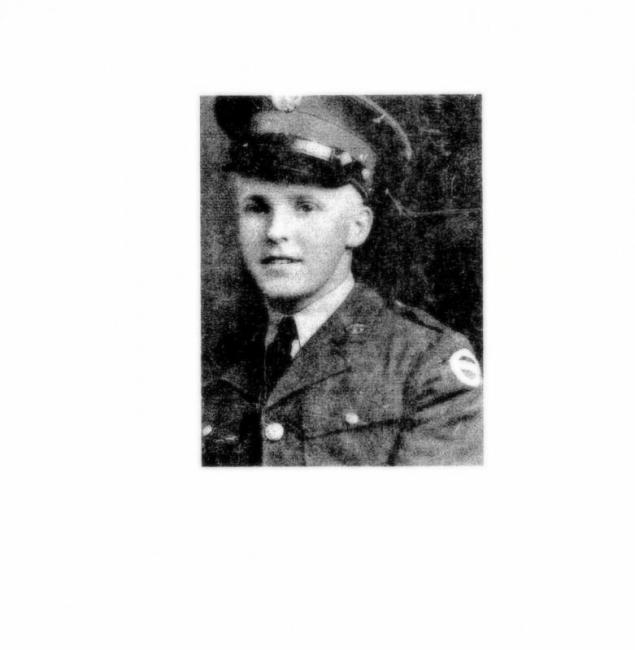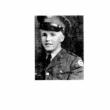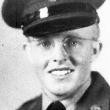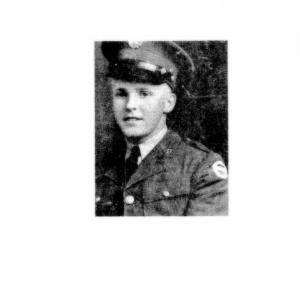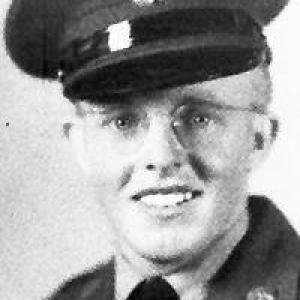Bringing Blondie Home: A Memorial Day Remembrance
Bringing Blondie Home
In early 1941 Maine’s Army National Guard was called to active status and sworn to Federal Service. Hundreds of young men in reserve units across Maine proudly donned their uniforms and reported for duty.
In Whitefield, three brothers had been preparing for this day. Russell, Walfred, and Shirley Sutherburg had been raised in a family proud to serve. They headed to Gardner to join their unit, Company M for deployment.
Their mother, Beatice Richardson Sutherburg was a nurse during World War I. Their father, John, was a disabled Veteran from that”war to end all wars.” It was expected that their eight sons would serve their country.
Four sons served in World War II before its end. Later two sons would serve in Korea and one in Vietnam.
On February 14, 1941, Shirley, Walfred” Blondie,” and Russell Sutherburg marched from the Brunswick Armory down Main St in Gardener to the train station with all of Company M, 103rd Infantry; 43rd Division.
During their training at Fort Blanding, the chance came for Walfred “Blondie” to fulfill a dream. The 18 year old loved winter sports and when the chance came to join the renowned 1Oth Mountain Ski Division in Italy he was first to volunteer.
His brothers Russell and Shirley were off to the South Pacific. The Sutherburg brothers were devoted to each other, and the separation was hard, but they all managed a furlough together at Christmas in 1943 back in Maine.
Nineteen year old Shirley Sutherburg was fighting with his unit at Munda Airport , New Georgia when he heard his brother Russell had been hit. He headed down the battlefield but did not make it to his brother . “All I remember is a flash,” he said,” then my lights were out. I woke up in a field hospital in Guadalcanal.” Sutherburg told the doctors to fix him up and send him back to his unit. “Why do you want to go back to that hell hole?” asked the doctor. “I have a brother there,” said Sutherburg.
While Shirley was being transported to a hospital in New Hebrides, his family in Maine was mistakenly notified that he was missing in action. “They had no records of my departure from New Georgia. I had been moved from New Hebrides to Auckland, New Zealand, and then to Letterman General Hospital in California, that’s when I could finally call my folks.” Eventually he was moved to Cambridge Ohio and his folks got there to see him. Russell had made it and was going to be ok.
Shirley was given a medical discharge because of the damage to his legs and out on a train from Texas back home to Maine. He was back at home in Newcastle in April 1945 going about his daily chores when a notice arrived from “B” Unit 32nd Field Hospital.
Telegrams only came for two reasons in those days: someone was wounded or dead in the War. It said: “ I regret to inform you your son, Sutherburg, Walfred, Pfc 2014597 Co D 87 Mt Inf. is seriously ill . Diagnosis: Penetrating Gunshot wound of chest.” The notification came on an index card sized paper, with the words “I am pleased to inform you” struck out and “ I regret to inform you” typed above it.
The notice of his death arrived on May 9th, 1945 in a telegram sent to his Mother, Beatrix Sutherburg. “Blondie” had died 10 days earlier in Italy.
By November of that year they were notified that their son’s body was coming home. They were given an estimate which ranged from five days to four weeks from the notification for the arrival of their son’s remains. All expenses were up to the families.
Pfc Walfred “Blondie” Sutherburg arrived home on a transport ship the Lawrence Victory with 7,129 other military casualties. Fifty-two of these soldiers were from Maine, all killed in action in Italy in a short period of time. The complete list , published on the front page of the Lincoln County News, covered half the page, in small print.
This was only one transport of many over the course of the war called “the deadliest military conflict in history” by the US Dept of Defense.
In World War II, getting the boys home posed a huge logistical challenge, since American war dead were scattered around the globe. Nearly 80,000 U.S. troops died in the Pacific, for example, and 65,000 of their bodies were first buried in almost 200 battlefield cemeteries there.
Once the fighting ended, the bodies were dug up and consolidated into larger regional graveyards. The first returns of World War II dead from the Pacific took place in the fall of 1947, six years after the attack at Pearl Harbor.
Eventually, 171,000 of the roughly 280,000 identified remains of US soldiers were brought back to the U.S.
Today, 73, 681 men are still listed as Missing in Action. The majority of MIA cases still unsolved are from WWII, followed by some 8,000 in the Korean War, 1,600 in Vietnam and about 125 related to the Cold War.
Bringing home soldiers to their families is relatively new in the annals of war. It is a sign of honor, respect and gratitude that The Nation now makes the return of fallen heroes a priority.
From the days when PFC Walfred “ Blondie” Sutherburg and his 51 compatriots from Maine waited for months to be returned to their families, to today when it is a matter of a week or so, the people of the United States of America still wait to welcome their fallen back to American soil.
Taps are played and 21 gun salutes are still fired. Families still stand to receive the folded flags, and young people still enlist to serve and protect their Country,
Veterans of all wars , wounded in body and in spirit, returned alive or dead, symbolize the best of American patriotism.
The Sutherburg family lost one son in World War II, one returned wounded and still the family proudly waved goodbye to every son in every conflict since World War I when both their parents served. One brother, Terry, survives today.
Shirley was awarded a Quilt of Valor a few years ago,. As he looked at it, he spoke of Blondie. “It’s for my brother, too” he said. Shirley Sutherburg’s daughter Dawn said, “ Dad never talked about the day they heard about Blondie, it was always too hard.”
Pfc Walford “ Blondie” Sutherburg was laid to rest with full military honors. He arrived home eight months after his death with over 7,000 other lost soldiers.
Our Service men and women are now returned home with a swiftness that could not have been imagined during World War II. There are teams of professionals who sew new uniforms, polish the medals and prepare them to be returned home.
The dignity and respect shown to the remains of our fallen heroes is unsurpassed. An escort travels with each soldier to ensure that they are returned safely to loving hands. What seems like the ‘least’ we can do as Americans now, began as an effort just to get them home at all in World War II.
The Sutherburg family laid their son to rest on a November day in 1945.
Blondie was home.
##
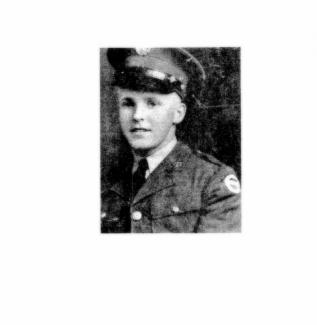 PFC Walfred “ Blondie” Sutherburg
PFC Walfred “ Blondie” Sutherburg
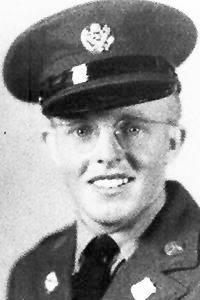 Shirley Sutherberg was just 17 on October 24, 1940 when he and his brother Walford “Blondie” enlisted.He started out with the kind of ingenuity that would stand him in good stead in the Military but sometimes would land him in the brig. He lied about his age to qualify. That alone wasn’t enough to get the determined boy into the service of his country. Shirley had bad eyesight. “Pretty terrible”, he remembers. He memorized the eye chart,
Shirley Sutherberg was just 17 on October 24, 1940 when he and his brother Walford “Blondie” enlisted.He started out with the kind of ingenuity that would stand him in good stead in the Military but sometimes would land him in the brig. He lied about his age to qualify. That alone wasn’t enough to get the determined boy into the service of his country. Shirley had bad eyesight. “Pretty terrible”, he remembers. He memorized the eye chart,
About this blog:

What's the Buzz" covers what's happening, what might be happening, and what should be happening in the opinion of the author.
Eleanor Cade Busby is an unpublished award-winning writer, photographer and blogger & simply loves writing about herself in third person.She published this absolutely all true bio.
Busby grew up all over New England,a preacher's kid who set out to destroy every single stereotype about a "Minister's Daughter."
She attended Goddard College, The Rhode Island Conservatory of Music and The School of Life, majoring in everything she could stuff into her head. She once had her own office and a red stapler. Her employees learned quickly never to touch it.
Much of her very long life has been spent on or back-stage at theaters. She penned a couple of plays, directed many more and acted in scores of productions. She's done it all except hanging lighting. You can't make her climb a ladder.
She won awards locally & nationally for social services and customer care. Most recently she was awarded the PEN/Toni and James C. Goodale Freedom of Expression Courage Award along with 3 million of her closest personal friends for "galvanizing a potent global movement to resist infringements on the rights and dignity of women and many other groups."
Busby has been a theater, art and dance reviewer and commentator for several publications, including CRACKED magazine.
Opinionated, obstinate, much-abused, and under-appreciated, she believes that if it isn't funny or relevant, it isn't worth it.
Eleanor Cade Busby lives in Midcoast Maine with two cats who like to stand on her head at 3 AM demanding a sacrifice, often her sanity.
Suggestions for topics and comments are always welcome at eleanorcadebusby@hotmail.com

